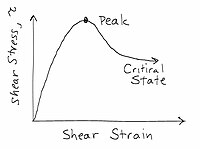
Photo from wikipedia
Abstract The Liquefaction Experiments and Analysis Projects (LEAP) provides an international collaboration platform to assess key aspects related to seismic induced soil liquefaction. Within this scope, the current study investigates… Click to show full abstract
Abstract The Liquefaction Experiments and Analysis Projects (LEAP) provides an international collaboration platform to assess key aspects related to seismic induced soil liquefaction. Within this scope, the current study investigates the influence of dilatancy and post-liquefaction shear strain on the seismic response of mildly sloping liquefiable ground, based on simulations of LEAP 2017–2019 centrifuge tests. A unified plasticity model for large post-liquefaction deformation, which has been implemented in the OpenSees finite element framework, is used in the numerical simulations. The model parameters are calibrated rigorously against element tests performed for Ottawa F65 sand used in LEAP 2017–2019, especially for liquefaction resistance and post-liquefaction shear strain observed in undrained cyclic hollow cylinder torsional shear tests. The calibrated model is used to simulate a series of centrifuge shaking table tests on sloping ground constructed at different soil densities. Good agreement between simulation and test results is achieved, validating the constitutive model and numerical simulation method. In depth analysis on the influence of dilatancy and post-liquefaction shear strain on the seismic response of the slope model is then conducted. The results show that these two factors can significantly affect the seismic acceleration, excess pore water pressure, and lateral displacement response of sloping ground, and therefore must be appropriately reflected in seismic liquefaction analysis oriented constitutive models.
Journal Title: Soil Dynamics and Earthquake Engineering
Year Published: 2020
Link to full text (if available)
Share on Social Media: Sign Up to like & get
recommendations!